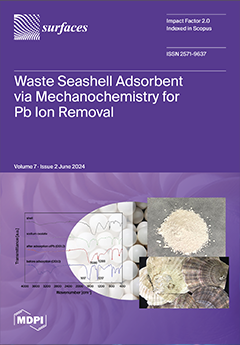Silicon is the most commonly used material in the microelectronics industry, due to its inherent advantages of high natural abundance, low cost, and high purity, coupled with the chemical and electrical stability at the interface with its oxide. For molecular electronics applications, oxide-free
[...] Read more.
Silicon is the most commonly used material in the microelectronics industry, due to its inherent advantages of high natural abundance, low cost, and high purity, coupled with the chemical and electrical stability at the interface with its oxide. For molecular electronics applications, oxide-free Si surfaces are widely used because of the relative ease of removing the oxide (SiO
x) by chemical means, yielding a surface which forms strong covalent bonds with a wide range of chemical functional groups; another advantage is that these surfaces remain oxide-free in the absence of oxidising agents. Standard procedures require the use of either HF, NH
4F, or a mixture of both as the etching solution; however, these two chemicals are highly corrosive and toxic, posing a significant risk to the experimentalist. Here, we report that for silicon wafers etched by using potassium fluoride, a less toxic chemical, the resulting surface is free of oxides and can be functionalized by self-assembled monolayers of 1,8-nonadiyne. To demonstrate this, Si/SiO
x wafers were etched by using either KF or NH
4F, followed by hydrosilylation with 1,8-nonadiyne and a click reaction of the terminal alkyne with azidomethylferrocene. The surface coverages and electron transfer kinetics of the ferrocene-terminated KF-etched surfaces are comparable to those formed by acidic fluoride etching procedures. This is the first study comparing the differences between surfaces functionalized by self-assembled monolayers of 1,8-nonadiyne which were etched by KF and NH
4F. KF could be used as a replacement chemical for etching silicon wafers when a less corrosive and toxic chemical is required.
Full article





